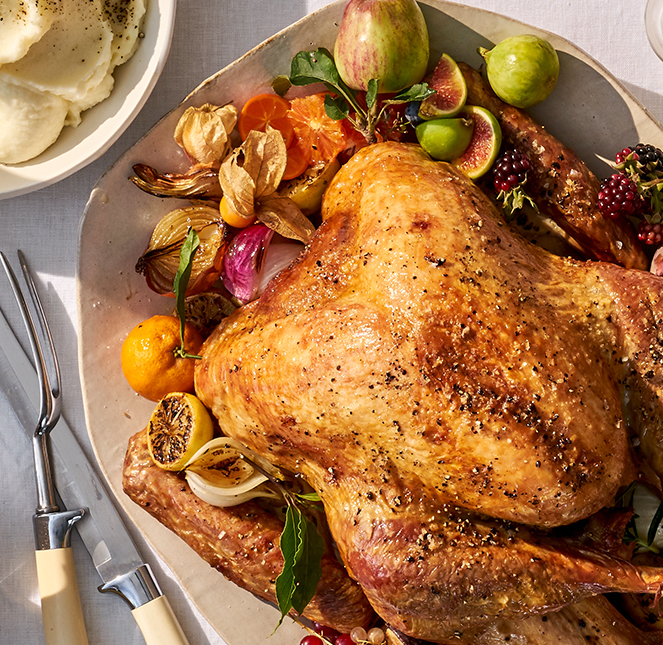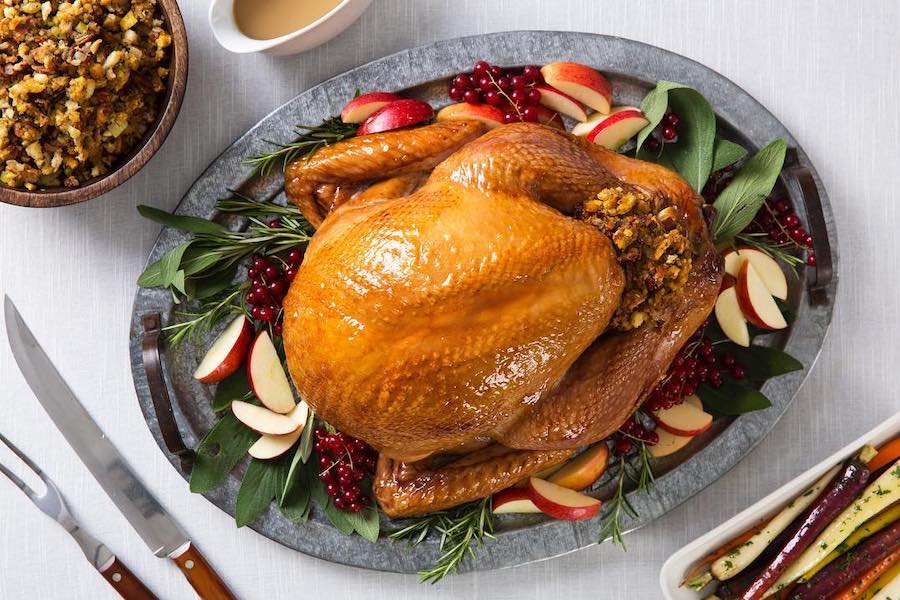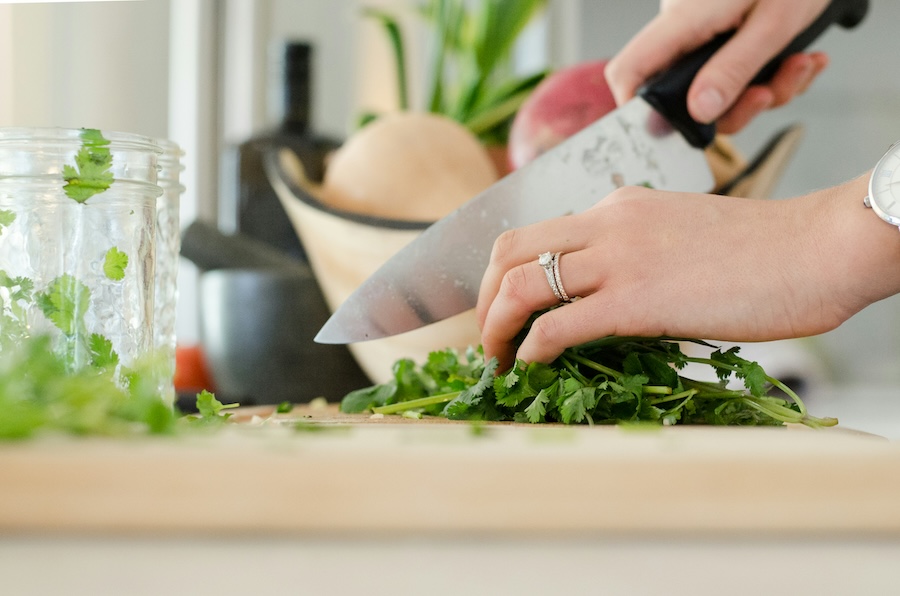Cooking a Thanksgiving turkey is always a little stressful – whether this is your 23rd Thanksgiving turkey in a row or your very first. What I’ve learned over the years is that guests (and their dietary restrictions!) change, budgets go up or down, labeling laws change, and all sorts of factors influence how to choose a turkey, and even how to prepare it.
(The brine debate is still going strong; even Tom Collichio and Alton Brown are having at it on Twitter this year!)
So I’ve created a simple guide to some of the most common labels and types of turkeys you’ll see, to help you figure out just how to choose the right turkey this Thanksgiving.
Just remember, choosing a turkey is a largely personal matter – there is no right or wrong type of turkey or a single right way to prepare it. I promise this decision will not make or break your Thanksgiving. (That’s a role for your in-laws, ha. Kidding!)
And hey, there’s always stuffing.
Top image: Apple Glazed Roast Turkey recipe via Butterball
Related:
How to cook a good turkey: A simple, easy-to-follow-guide
5 most common turkey problems and how to fix them.
A terrific list of the best Thanksgiving cooking hotlines for all the help you need
5 top food bloggers share their favorite Thanksgiving stuffing recipes
How to choose the right Thanksgiving turkey:
Understanding all those labels and terms

Turkey Label t-shirt from Teepublic. At least, this is the info before all the stuffing and sides, right?
1. Fresh vs Frozen?
Sticklers may disagree, but here’s the truth: In terms of actual taste, there won’t be a big difference between fresh and frozen turkey.
My primary concern with buying a frozen bird is the thawing time – which is long. About a day in the fridge for every five pounds. And you should always remember to bring your turkey close to room temperature before you start roasting.
There’s also a chance freezing can compromise the structure of the meat; because when ice crystals form, they may slightly alter the meat’s texture.
That being said, frozen turkeys can be extremely convenient for if you want to shop early. And with all that gravy and stuffing slathered on, I doubt the crowd would notice any difference.
2. 12-pound. vs 15-pound. vs 20-pound vs….?
When considering the size of a turkey, the standard rule is 1 – 1 ½ pounds per person. (Or at least poultry-eating adults who will indulge in a full serving.
My rule is 1 ½ pounds per person. After all, leftovers are as much a part of Thanksgiving as anything else. So a 12-pound turkey is great for 8 turkey-eaters, and feel free to make some adjustments for smaller children.
But! Keep in mind that all birds are not created equal. A large bird may not be as tender as a smaller one. If you are feeding your family plus all of Aunt Betsy’s grown football-playing sons, consider getting two smaller birds instead of on big one.
3. Self-basting/Injected?
“Self-basting” is a term for a bird, generally frozen, that has been infused with a salt and flavor solution, or brine. This process is used in most commercial turkeys to add moisture during roasting and cut back on work for you (like salting the bird before cooking). If you go this route, always look closely at the label to see what is in the solution.
The alternative is a “natural” turkey which hasn’t been processed at all. Those who prefer this kind of turkey do so because they say the liquid masks the natural turkey flavor, and prefer a less processed bird. Going this route takes a bit more prep and cooking on your part, like needing to brine or salt yourself.
Pro tip: Whether your turkey is natural, organic or otherwise, as long as it’s not pre-brined or Kosher, I recommend a dry brine. It’s just a fancy term for salting the turkey the day before. You’ll want to salt the bird all over, inside and out, the day before cooking and store in the fridge overnight, uncovered. This will amp up the flavor and moisture of your turkey and help with the crisping of skin. Brine
4. Kosher vs Non-Kosher?
You don’t have to be kosher yourself to prefer a turkey that has been killed and processed according to Jewish/kosher law — which by most accounts is a lot more humane. And a lot of people prefer them for the flavor as well; kosher turkeys are salted inside and out, therefore, they do not need any extra salting or brine before cooking.
Kosher birds (Empire Kosher is quite popular) can generally more expensive than non-kosher turkeys, but it may be worth the trade-off for the flavor and the ease in preparation.
5. Organic or Free-range?

Whole Foods has a great selection of organic turkeys, as you’d expect
Organic turkeys are those that have been raised free of chemicals, antibiotics or fertilizers. They are even highly recommended by Consumer Reports, which states that antibiotic-free and organic poultry tend to carry fewer antibiotic-resistant bacteria. (That’s good!) And the test kitchen folks at Cooks Illustrated claim both organic and “vegetarian-fed” turkeys offer the best flavor.
“Free-range” means the turkeys have access to ample outdoor space. The conditions also help exercise the bird’s muscles, often resulting in more flavorful meat.
Just keep in mind that while we often see these two terms together, a free-range turkey does not mean the turkey has been fed an organic or vegetarian diet. Also good to note: Even a turkey labeled USDA organic may have been given antibiotic injections before it hatched and up until its second day of life.
7. Cage-free or hormone free?
[Edited for clarity] While the majority of turkeys are raised cage-free, that is not the same as “free-range,” and doesn’t guarantee that they are raised humanely. So if cage-free or free-range (access to outdoors) are important attributes to you, research your turkey manufacturer first.
As for hormones, lot of brands proclaim “hormone free!” on their packaging as if it’s some unique benefit, but it’s not — all turkeys must be hormone-free per USDA law. In other words, if the only benefit of your turkey is that it seems to be hormone-free, it’s just a regular old turkey.
Related: 5 top food bloggers share their favorite stuffing recipes.
8. Heritage?
Heritage turkeys tend to be smaller with more dark meat, are older at the age of slaughter and well, it’ll cost you.
Fans say heritage turkeys taste the way turkeys used to be, i.e. how they’re supposed to be. But I for one don’t really have a reference for how things were 100 years ago.
However, I do like the idea of ordering a turkey from a local farm. If you’re considering this option, research farms nearby and plan to order early. Smaller farms tend to have a legion of fans who support them each year, and their turkeys will sell out.
9. “Natural”/ standard supermarket?

If you’re looking for the easiest, most affordable option, then you’re looking for birds that are often labeled “natural” (which doesn’t mean much at all in the turkey-labeling world) or perhaps don’t even have a special label.
They aren’t pre-brined. They aren’t frozen. They shouldn’t contain any additives. But they may offer benefits like no-antibiotics.
To help you select the best one, your supermarket managers or butchers will most likely be the best people to ask if you have specific questions. They’ll also let you know how early to place an order.
If you’d like a brand redo, personally, I’ve had luck with my local market’s own brand, and with Bell & Evans turkeys in the past.
B&E turkeys are antibiotic-free, which is a hard thing to find — Wired reports that it’s 10-times harder to raise an antibiotic-free turkey than a chicken. What I really love, is that they’re air-chilled, and this method eliminates the need for any added water so the bird’s natural juices are not diluted. I can’t prove this, but I also think that helps to achieve more crispy skin.





